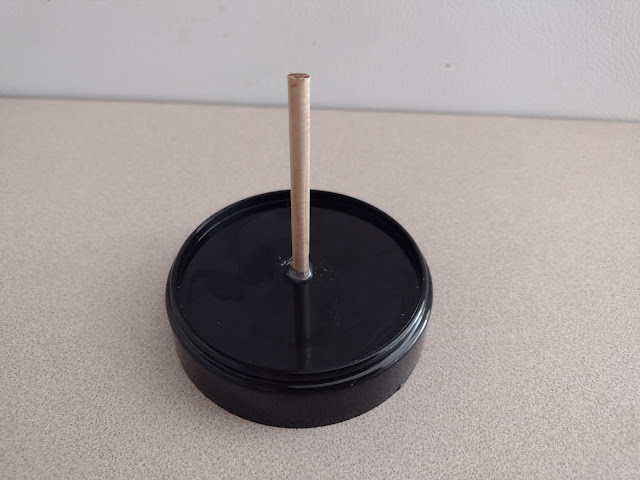$5 - $10 (based on 2020 prices)
Makes one display
Makes one display
Among the last builds for the laboratory theme was a series of small cloches containing a single specimen – an ear, an eye, and teeth – which served as small details placed among the larger towers of equipment. Featured here is the version with the teeth (see the ear and eye versions here).
- One plastic cloche with detachable base (roughly six inches tall)
- One 10 oz. can of interior/exterior, fast-drying spray paint in flat black*
- One 10 oz. can of interior/exterior, fast-drying spray paint in metallic silver*
- One 8 oz. can of oil-based interior wood stain in red chestnut*
- One 8 oz. can of oil-based interior wood stain in Jacobean*
- One 2 oz. bottle of acrylic paint in flat brown*
- One 4 oz. bottle of all-purpose tacky glue*
- One set of resin false teeth with gums
- One 0.44 oz. bottle of clear nail polish
- One to two feet of red yarn
- One 3/16” wooden dowel
2. On a newspaper-lined surface in a well-ventilated area, build up layers of black and metallic silver spray paint to give the base and dowel the look of steel. It works best to apply a base coat of black followed by sliver, working in quick bursts to allow parts of the black to remain visible. You can also touch up portions with additional blasts of black if the silver becomes too heavy.
3. Once the spray paint dries, create a wash of brown paint and use it to add a level of grime to the prop, allowing the liquid to settle in the crevices.
4. Separate the teeth from the gums and, on a newspaper-lined surface in a well-ventilated area, use the red chestnut wood stain to paint the gums and the Jacobean wood stain to age the teeth. By using both colors, it gives the prop contrast: the meaty tint from the red chestnut and the dull grime from the Jacobean.
5. Cut seven strands of red yarn in varying lengths and fray their ends. After this, apply a light layer of glue to the back and front of the gums and use the frayed stands to make veins. Try not to overthink their placement because a random pattern will look gorier and more unsettling. After the glue dries, coat the veins with the clear nail polish to give them a glossy appearance and lock the strands in place. You can also use a glossy decoupage medium for this process if the fumes from the nail polish become too overpowering.
6. Attach the teeth to the gums and glue the prop on the top of the dowel. Depending on the height of the cloche, you may need to play with its placement or shorten the dowel so it fits properly under the enclosure.
7. Coat the remaining portions of the yarn strands in glue and wrap them around the dowel, using a needle or fine-tipped object to spread the fibers outward along the base to form tendrils. Once you have achieved your desired look, coat the yarn in nail polish to make it look moist.
8. On a newspaper-lined surface in a well-ventilated area, paint the cloche with the Jacobean wood stain. Start by applying a thin coat and patting it with paper towels to produce a hazed appearance. Then, brush the edges to create the illusion of grime buildup. You want to refrain from making the coverage too thick, though, because it can obscure the teeth inside.
9. After the stain has dried, reattach the cloche to its base. For additional detail, you can embellish the prop with a specimen tag or biohazard label to cater it to your haunt’s theme.
*You will not use the entire bottle’s content for this project.










No comments:
Post a Comment